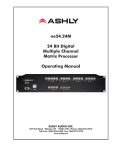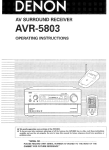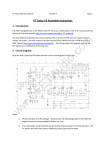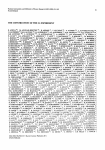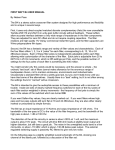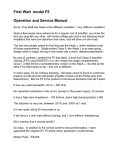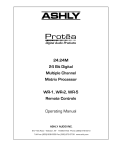Download Hafler 915 Stereo Amplifier User Manual
Transcript
Haflee H O M E A U D I O C O M P O N E N T S Series 915 Preamp Series 0915 P R E A M P L I F I E R NOTICE - IMPORTANT SAFETY INFORMATION RISK OF ELECTRIC SHOCK 00 NOT OPEN WARNING: TO PREVENT FIRE OR SHOCK HAZARD, DO NOT EXPOSE THIS EQUIPMENT TO RAIN OR MOISTURE. 1. A I 0 A The lightning flash with arrowhead symbol within an equilateral triangle is intended to alert the user to the presence of uninsulated “dangerous voltage” within the product’s enclosure, that may be of sufficient magnitude to constitute a risk of electric shock to persons. The exclamation point within an equilateral triangle is intended to alert the user of the presence of important operating and maintenance (servicing) instructions in the literature accompanying the appliance. READ INSTRUCTIONS All the safety and operating instructions of your Hafler equipment should be read before power is applied to the equipment. 2. RETAIN OWNERS MANUAL These safety and operating instructions should be retained for future reference. 3. HEED WARNINGS All warnings on the equipment and in the operating instructions are important and should be followed. 4. FOLLOW INSTRUCTIONS All operating and use instructions are important and should be followed. 5. HEAT The equipment should be kept away from areas of high temperature, such as heater vents, radiators, stoves/ovens, fireplaces, etc. 6. VENTILATION The equipment should be used in an area suitable for proper ventilation. Care should be taken not to impede airflow in and around the cabinet. Do not mount on a carpeted shelf or in a sealed enclosure. Allow for proper clearance above the equipment. 7. WATER AND MOISTURE The equipment should not be used in or around water, such as a bathtub, sink, or swimming area. Also, the equipment should not be used in areas prone to flooding, such as a basement. 8. POWER SOURCES The equipment should be connected only to a power source of the same voltage and frequency as that listed on the rear panel above the power cord entry point. 9. POWER CORD PROTECTION Power cords should be arranged so that they do not interfere with the movement of objects in the room: people, fan blades, utility carts, etc. Also, care should be taken that the cord is not pinched or cut, and placed so that it is not in danger of being pinched or cut, as in under a rug, around a tight corner, etc. 10. POWER CORD GROUNDING The power supply cord is of a three wire grounded type, designed to reduce the risk of electric shock sustained from a live cabinet. It is assumed to be of suitable length for most uses of the equipment. The use of extension cords and power strips is discouraged unless they are of suitable rating to deliver the required total current for safe operation of all connected equipment. Furthermore, extension cords or power strips must provide the same three wire grounded connection. It is important that the blades of the equipment’s plug be able to fully insert into the mating receptacle. Never remove the round grounding pin on the plug in an attempt to mate to a two wire ungrounded receptacle: use a grounding adaptor with the grounding tab or wire suitably connected to earth ground. -l- 11. NON-USE PERIODS During periods of extended non-use, the power cord should be unplugged from the power source. 12. CLEANING The equipment should be cleaned only as detailed in the operating instructions. 13. OBJECT AND LIQUID ENTRY Care should be taken so that objects and/or liquids, such as cleaning fluids or beverages, are not spilled into the enclosure of the equipment. 14. DAMAGE REQUIRING SERVICE Hafler equipment should be serviced by qualified service personnel when: A. The power supply cord or plug has been damaged, or B. Objects have fallen, or liquid has been spilled into the equipment, or C. The equipment has been exposed to rain, or D. The equipment does not appear to operate normally or exhibits a marked change in performance, or E. The equipment has been dropped, or the enclosure has been damaged. 15. SERVICING The user should not attempt to service the equipment beyond that which is described in the operating instructions. All other service should be referred to qualified service personnel. 16. CARTS AND STANDS The equipment should be used with carts or stands only of sufficient strength and stability for the use intended. An equipment and cart combination should be moved with care. Quick stops and starts, excessive force, and uneven surfaces may cause the equipment and cart combination to topple. -2- TABLE OF CONTENTS PERFORMANCE SPECIFICATIONS ............................................................................................ General Information ............................................................................................................... 4 5 INSTALLATION Rackmounting ........................................................................................................................ Ventilation/Placement ............................................................................................................ Line Voltage ........................................................................................................................... 5 5 5 OPERATION/CONNECTIONS Power Cord Connection ........................................................................................................ Initial Power-Up/Muting System ............................................................................................ Convenience Outlets ............................................................................................................. Line Level Inputs ................................................................................................................... Phono Section ....................................................................................................................... Front Panel View Diagram ..................................................................................................... Rear Panel View Diagram ..................................................................................................... Tape Input/Record Output ..................................................................................................... Tone Controls/Tone Switch ................................................................................................... Volume Control ...................................................................................................................... Balance Control ..................................................................................................................... Out 1, Out 2, And Output Switch ......................................................................................... Headphone Output .............................................................................................................. 5 5 6 6 6 7 8 9 9 9 9 10 10 CIRCUIT DESCRIPTION Phono Section ...................................................................................................................... Line Level Inpu? Selector System ......................................................................................... 10 10 J-FET Buffer And Record Output Driver.. ............................................................................ Tape Monitor Switching ........................................................................................................ Volume And Balance Controls.. ............................................................................................ Line Amplifier.. ..................................................................................................................... Tone Control System ............................................................................................................ Muting System ..................................................................................................................... Power Supply ....................................................................................................................... Headphone Amplifier ........................................................................................................... 11 11 11 11 11 11 11 12 ADDITIONAL INFORMATION Installing Phono Option ....................................................................................................... Phono Board Installation Diagram ....................................................................................... Installing Cartridge Loads .................................................................................................... Changing Line Voltage Rating ............................................................................................. Cartridge Loads Installation Diagram .................................................................................. General Troubleshooting Hints ............................................................................................ Ground Loops ...................................................................................................................... Cleaning/Maintenance ......................................................................................................... Functional Block Diagram .................................................................................................... Main Board Parts List .......................................................................................................... Main Board Component Layout Diagram ............................................................................ Main Board Circuit Schematic Diagram ............................................................................... Phono Board Parts List ........................................................................................................ Phono Board Component Layout Diagram .......................................................................... Phono Board Circuit Schematic Diagram ............................................................................ .12 .13 .14 .14 .15 .16 .17 .17 .18 .19 .20 .21 .22 .23 .24 SERVICE POLICY AND LIMITED WARRANTY ......................................................................... .25 -3- PERFORMANCE SPECIFICATIONS All specifications are for 20 Hz - 20 kHz unless specified otherwise. PHONO SECTION (Measured At REC OUT) FREQUENCY RESPONSE: +/-0.1 dB MAXIMUM OUTPUT: 5 volts RMS TOTAL HARMONIC DISTORTION AND NOISE: Moving Magnet: .002% Moving Coil: .009% SENSITIVITY (For 0.5 volts RMS at REC OUT, @ 1 kHz): Moving Magnet: 6.0 mV RMS Moving Coil: 600 uV RMS SIGNAL TO NOISE RATIO (A-weighted, relative to 0.5 V RMS at REC OUT): Moving Magnet: -87 dB Moving Coil: -80 dB MAXIMUM INPUT SIGNAL (@ 1 kHz): Moving Magnet: 65 mV RMS Moving Coil: 6.5 mV RMS INPUT IMPEDANCE: Nominal: 47,000 ohms Moving Magnet: 220 pF as supplied, user adjustable Moving Coil: 100 ohms as supplied, user adjustable GAIN (@ 1 kHz): Moving Magnet: +38.5 dB Moving Coil: +58.5 dB LINE AMPLIFIER (Measured at OUT 1 or OUT 2) FREQUENCY RESPONSE: +/- 0.1 dB (into 33,000 ohms) BANDWIDTH: 8 Hz - 170 kHz, -3 dB, into 10k ohm load MAXIMUM OUTPUT: 6 volts RMS TOTAL HARMONIC DISTORTION AND NOISE: .008% @ 2 volts RMS SENSITIVITY (For 0.5 volts RMS Output): 45 mV RMS SIGNAL TO NOISE RATIO (A-Weighted, relative to 2 volts RMS output): -100 dB INPUT IMPEDANCE: 20k ohms (including PHONO/AUX1 when phono option not installed) OUTPUT IMPEDANCE: 316 ohms TONE CONTROLS> HEADPHONE AMPLIFIER Bass: +/- 16 dB @ 20 Hz, moving inflection, variable turnover Treble: +/- 14 dB @ 20 kHz, shelving @ 5 kHz, fixed turnover MAXIMUM OUTPUT: 4 volts RMS into 150 ohm load OUTPUT IMPEDANCE: 150 ohms -4- GENERAL INFORMATION j INPUTS: Tuner, Video, CD, Phono/Aux 1, Aux 2, Tape Monitor OUTPUTS: Out 1, Out 2, Record Out, Headphone CONTROLS: input Selector, Volume, Tape Monitor , Tone Control In, Balance, Bass, Treble, Output Off, Power, Phono MM/MC INDICATORS: Mute/Standby, Power CONVENIENCE OUTLETS: 1 Unswitched, 4 Switched (Polarized) (Convenience Outlets are not included on 200-240 VAC units) PHYSICAL DIMENSIONS: 17” (W) x 7-5/8” (D) x l-3/4” (H) (excluding feet); Faceplate 17” or 19” (W). 43.2cm (W) x 19.4cm (D) x 4.5cm (H) (excluding feet); Faceplate 43.2cm or 483cm (W). POWER CONSUMPTION (Excluding Convenience Outlets): 9 watts Max. AC LINE VOLTAGE OPERATING RANGE: (exceeding lower limit will activate muting circuit; exceeding upper limit will result in overheating and/or component damage) 100 - 120 Volt 50/80 Hz Models: 85 - 130 volts 200 - 240 Volt 50/80 Hz Models: 170 - 280 volts INSTALLATION RACKMOUNTING The 915 Preamplifier is supplied in either a 17” Black Version, or a 19” Silver Version. The 19 model has rackmounting holes provided for installation in equipment racks. The holes are on standard EIA spacings. VENTllATlON/ PLACEMENT The 915 produces very little heat during operation, and therefore requires no special considerations for ventilation. The preamplifier should be located at least several inches away from components that contain large power transformers (such as power amplifiers), due to the possibility of audible hum or buzz from magnetic radiation. LINE VOLTAGE The 915 Preamplifier is configurable for either 100 - 120 volt, or 200 - 240 volt operation. This is accomplished by changing internal jumpers on the printed circuit board. The procedure is detailed in the section “CHANGING LINE VOLTAGE RATING”. Make sure that the unit is configured for your local AC line voltage before attempted use. The configuration is labelled directly above the power cord connector. OPERATION/CONNECTIONS POWER CORD CONNECTION Units wired for200-240 VACare supplied without power cords. Local agents will supply cords with male connectors appropriate to the local standard. Units wired for 100-120 VAC are supplied with a detachable AC power cord. The female connector plugs into the receptacle provided on the rear panel. This power cord is a standard IECType Type320, 320, 3-wire, gauge assembly. Should replacement ever be necessary, be sure to IEC 3-wire, 18 18 gauge replace it with an identical cord. Never remove the grounding pin from the male end of the cord. In applications where a grounded wall outlet is not available, a ground adaptor should be employed, with the ground tab or wire of the adaptor connected to a suitable earth ground. INITIAL POWERUP/MUTING SYSTEM For units wired for 200-240 VAC, the front panel Power Switch controls the power to the Preamplifier’s circuitry. If desired, this switch may be left “on” at all times to allow circuits to be thermally stabilized for maximum fidelity as soon as the system is used. -5- For units wired for 100-120 VAC, the Power Switch controls the Switched Convenience Outlets only. As soon as the 915 is plugged into the AC line, power is applied to the circuitry (regardless of the position of the front panel Power Switch). Therefore, all connections should be performed with the unit unplugged. For all units, when power is applied, the Ready Light will glow red for several seconds, indicating that the Audio and Headphone Outputs are muted. Once the delay period has passed and the power supply has stabilized, the light will turn green. The preamplifier is now ready to enjoy. The muting will reactivate immediately (and the Ready Light turn red) upon loss of AC line voltage, (or operating the Power Switch on 200-240 VAC units), or if line voltage falls below a level which precludes proper operation of the preamplifier’s circuitry. CONVENIENCE OUTLETS Units wired for 200-240 VAC are supplied without convenience outlets to conform to Regulatory Safety requirements. Units wired for 700- 720 VAC have a total of five outlets for connection of associated components. The Unswitched Outlet is powered at all times, which should generally be used for a turntable or tape deck. The remaining four Switched Outlets are powered when the front panel Power Switch is engaged, as indicated by the switch’s green pilot light. The maximum power available from these outlets is 1200 watts total. This total power may be drawn from a single outlet, or a combination of outlets. Since some power amplifiers consume more than 1200 watts at maximum output, check the power amplifier’s rating before connecting to these convenience outlets. LINE LEVEL INPUTS The inputs labelled CD, Tuner, Video, Aux 2, and Phono/Aux 1 (when the Phono Option is not installed), are identical line level inputs. The names chosen for these inputs are for convenience only, and may be used interchangeably, or for any other type of line level source. These inputs are selected via the rotary front panel Selector Switch. The Phono/Aux 1 input is converted from a line level input to a high gain RIAA phono input when the Phono Option is installed. See Phono Section. The 915 Preamplifier is available with an optional Phono Amplifier section. This option may be installed at time of purchase, or at a later date. Inclusion of this option is indicated by the presence of a switch button protruding from the rear panel opening marked MC/MM. Otherwise, this opening will be filled by a plastic cover. The MC/MM switch should be set to MC for low output (typically 0.2 - 0.5 mV) moving coil cartridges, and set to MM for high output (2 - 5 mV) moving coil cartridges or moving magnet cartridges. NEVER OPERATE THE MC/MM SWITCH UNLESS THE VOLUME CONTROL IS TURNED FULLY DOWN. The very high gain present in the Phono Amplifier can result in switching transients capable of blowing amplifier or speaker fuses, and possibly damaging some loudspeakers. PHONO SECTION (When Installed) The ground terminal near the MC/MM switch is provided for turntable frame grounding via the extra ground wire provided on most turntables. As supplied from the factory, the phono cartridge input termination is 47,000 ohms in parallel with 220 pF in the Moving Magnet mode, and 100 ohms in the Moving Coil mode. The value of capacitance and resistance is user selectable via plug-in components. See “Installing Cartridge Loads” for further information and instructions. -6- INPUT SELECTOR BALANCE VOLUME CONTROL I -l I CONTROL TREBLE CONTROL BASS CONTROL HEADPHONE JACK POWER SWITCH UP TO TURN ON SWITCHED OUTLETS* 0 0 w . RACKMOUNT HOLES (19” VERSION ONLY) TAPE MONITOR SWITCH UP TO MONITOR TAPE INPUT TONE IN SWITCH UP TO ACTIVATE BASS & TREBLE OUTPUT OFF SWITCH UP TO TURN OFF OUT1 &OUT2 915 PREAMPLIFIER FRONT PANEL VIEW *lOO-120 VAC UNITS ONLY. 200-240 VAC UNITS ARE WITHOUT CONVENIENCE OUTLETS: POWER SWITCH CONTROLS PREAMPLIFIER POWER. A CJ READY LIGHT RED FOR MUTE ACTIVATED GREEN FOR OPERATE 0 UNSWITCHED LINE VOLTAGE RATING LINE CORD CONNECTOR AC SWITCHED OUTLETS OUT 1 TAPE AUX 2 TUNER INPUTS VIDEO TOP ROW - RIGHT CHANNEL BOTTOM ROW - LEFT CHANNEL OUTPUTS REC OUT OUT 2 CD 200-240 VAC UNITS ARE WITHOUT CONVENIENCE OUTLETS. *100-l 20 VAC UNITS ONLY. PHONO CHASSIS GROUND MC/MM SWITCH (PHONO OPTION ONLY) IN-MOVING COIL OUT - MOVING MAGNET PHONO/AUX 1 915 PREAMPLIFIER REAR PANEL VIEW OUTLET* TAPE INPUT/ RECORD OUTPUT The 915 incorporates one monitoring loop for use with tape decks, or other input/output signal processors. The Ret Out jack feeds a signal to a tape recorder’s input. The signal present at this output is the same as indicated by the Selector Switch. This output may alternately be used to feed the input of a signal processing device, such as an equalizer. Though rare, it is possible that some external devices connected to Rec Out may cause slight distortion to the main signal path when that device is turned off. This is due to possible semiconductor junction rectification in unpowered circuits. If this is suspected, leave power applied to any device connected to Rec Out during critical listening. The Tape Input is electrically the same as the other line level inputs, but is selected via the Tape Monitor Switch. Activating this switch (UP position) breaks the main signal path after the Input Selector System and allows monitoring of the tape decks output, during recording or playback. Activating this switch does not affect the signal at the Rec Out jacks. The Tape Input may alternately be used for the return signal from a signal processing device, such as an equalizer. The Tape Input may also be used for an additional line level input, although this signal cannot be made available to the Rec Out jacks. A common system “malfunction” can often be traced to inadvertently leaving the Tape Monitor Switch engaged: in case of no sound from a selected line level input, check that the Tape Monitor Switch is de-activated (DOWN position). See the Functional Block Diagram for a better understanding of the Tape Monitor Signal routing. TONE CONTROLS/ TONE SWITCH The Tone In Switch activates the Bass and Treble Controls when moved to the UP position. I n the DOWN position, the Tone Controls are completely removed from the signal path, regardless of Bass and Treble knob position. The Bass Control has a variable inflection, or “hinge” point so that only the very low frequencies are affected by small amounts of knob rotation on either side of center. This facilitates small amounts of low frequency corrections without noticeably altering the musical balance at upper bass frequencies. As the knob rotation is increased further from center, frequencies closer to 500 Hz are affected. The Treble Control has a fixed “hinge” point at 1 kHz and has a “shelving” action above 5 kHz. This affords proper high frequency corrections without irritation from excessive boost at extreme high frequencies. Activating the Tone Control Switch may cause a slight change in tonal balance even when both Bass and Treble controls are in their center detented position, and therefore the Tone System should be disabled via the switch when no tone control action is desired. The tone controls also limit the total bandpass of the line amplifier. VOLUME CONTROL This precision detented potentiometer increases output level in approximately 1 dB steps clockwise from the 12 o’clock position. Counterclockwise from the 12 o’clock position, each step is progressively greater until full attenuation is achieved at maximum counterclockwise position. This arrangement allows the most natural and useful volume control action for a wide variety of listening levels. BALANCE CONTROL This control alters the proportion between right and left output volumes. In the full counterclockwise position, only the left channel will be heard. In the full clockwise position, only the right channel will be heard. The Balance Control is useful for balancing the acoustic output of the system between left and right speakers, as well as being useful for system troubleshooting. -9- OUT 1, OUT 2 AND OUTPUT OFF SWITCH Activating this switch (UP position) turns off both Out 1 and Out 2. It does not affect the headphone output. This control is useful for turning off the signal to the power amplifier(s) during headphone listening, or for general system muting purposes. When activated, the output switch disconnects the line amplifier from the output jacks, and grounds the jacks to prevent possible system noise due to open amplifier inputs. Out 1 and Out 2 are connected in parallel, to provide two equal outputs to amplifiers. This feature is useful for bi-amplified speaker systems, or for running two amplifier/speaker systems. A common system “malfunction” can often be traced to inadvertently leaving the Output Off Switch engaged. In case of no sound from the speakers, check that the Output Switch is de-activated (DOWN position). HEADPHONE OUTPUT The headphone receptacle is a standard 1/4” stereo phone jack, with the tip of the plug as the left channel, the ring the right channel, and the barrel ground. The headphone driver circuit is separate from the main line amplifier, and therefore, driving headphones will not cause distortion on the main outputs. Unless simultaneously operating loudspeakers during headphone use, the Output Off Switch should be used to disable the outputs. Remember to reduce the Volume Control setting before turning on the outputs again, since a normal listening level for headphones may correspond to a surprisingly high volume for loudspeakers. CIRCUIT DESCRIPTION PHONO SECTION (When Installed) Each Phono channel consists of six low-noise JFET's connected in a complementary-symmetry, nondifferential configuration. Shorted-input moving coil equivalent-input noise measures about -137 dB (140 nV) wide band. Only two stages are used to yield an open-RIAA-loop gain of about 110 dB in moving coil mode and 90 dB in moving magnet mode. RIAA loop closure yields 58.5 dB and 38.5 dB respectively, at 1 kHz. The first stage employs an active load technique in which the load JFET’s are connected as gyrators, acting as if they were very large inductors. This arrangement allows very high gain at low frequencies and a natural roll-off of high frequencies in the amplifier loop, before the RIAA negative feedback loop is closed. DC operating point stability is obtained by long time constant DC negative feedback applied from output to intermediate points in the gain structure. AC gain is set by the RIAA network feeding back output signals to the sources of the input JFET pair. Switching to moving coil (MC) from moving magnet (MM) results in three operational changes: 1) open-loop gain is increased by 20 dB, 2) closed-loop gain is increased by 20 dB, and 3) user adjustable cartridge loading is changed from capacitive to resistive. The phono outputs are capacitively connected to the high level Input Selector System. INPUT LINE LEVEL SELECTOR SYSTEM The front panel rotary input Selector Switch creates digital codes fed to a CMOS-FET electronic switch. This arrangement eliminates signal degradation due to mechanical switch contacts, and allows the electronic switches to be located close to the rear panel inputs for minimum signal path lengths and reduced interchannel crosstalk. The output of the Selector System is grounded between positions of the rotary knob to minimize switching noise. -lO- JFET BUFFER AND RECORD OUTPUT DRIVER The output of the Selector System is followed by a very high input-impedance JFET buffer pair to establish negligible CMOS switch loading (for low distortion) and to provide a low-impedance source for the Record Output and the Volume and Balance controls. TAPE MONITOR SWITCHING The Tape Monitor Switch drives a relay to break the line input path to insert tape input signals. The relay employs gold plated contacts, and allows optimum signal routing by placing the relay close to the Tape Input jacks and the Input Selector System. VOLUME AND BALANCE CONTROLS The Volume Control is a precision detented potentiometer employing laser-trimmed elements for precise channel-balance tracking and a multi-finger wiper for smooth action, prolonged life, and minimum contact noise. The center-detented Balance Control yields channel balance within 0.1 dB in its center position. LINE AMPLIFIER The 915 Line Amplifier is a Class-A JFET design employing a differential input stage, driving a complementary high gain output stage, symmetrically driven for balanced slew-rate and low harmonic distortion. This topology uses only four active devices per channel and extremely short loop feedback, yielding high bandwidth and excellent stability. The feedback loop contains two user selectable paths: one conventional path for flat response, and another path allowing insertion of a tone control network. This arrangement allows maximally flat response and the shortest, cleanest signal path when tone control action is not required. The output of the Line Amplifier is capacitor coupled to the outputs of the preamplifier. TONE CONTROL SYSTEM The Tone In Switch allows complete removal of the tone controls from the signal path. This switching is accomplished with the same type of CMOS-FET electronic switch used for the Input Selector. This switching arrangement eliminates signal degradation due to mechanical switch contacts, and allows the electronic switch to be located very close to the Line Amplifier circuitry. The Bass Control is of a moving inflection, variable turnover type, and the Treble Control is of a shelving, variable turnover type. These types of tone controls offer the best “tools” for modifying tonal balance without introducing unwanted side effects. MUTING SYSTEM The Muting System monitors the difference between the raw (unregulated) power supply voltage and the regulated power supply voltage. During the power-up cycle, the Audio and Headphone Outputs are muted until the difference between the unregulated and regulated voltages reaches a predetermined level, and then remain muted for several seconds to allow all circuitry to stabilize. During power-down, or in cases of excessively low AC line voltage, the Audio and Headphone Outputs are instantly muted to avoid extraneous noises. The muting is accomplished by grounding the output of the Line Amplifier, using a relay with gold contacts. POWER SUPPLY The printed circuit board mounted power transformer utilizes dual primaries for worldwide operation. Internal jumpers configure the power supply for rated operation from 100 to 120 VAC, or 200 to 240 VAC, at 50 or 60 Hz. A generous amount of power supply headroom allows actual operation over much wider ranges of 85 to 130 VAC, or 170 to 260 VAC. The power transformer feeds a conventional split full wave bridge rectifier system. Power supply capacitance is 4700 pF per rail. Stable and consistent ± l5 volt power for the amplifier circuits is provided by three-terminal heatsink-mounted regulators. Further local power supply filtering of 470 UF per rail is provided for each channel of the Line and Phono Amplifiers. All electrolytic filter capacitors are bypassed by high quality film capacitors. -ll- Internal signal grounding has been carefully routed to follow the signal path from the input jacks, through the Selector System, through the Volume and Balance Controls, and finally to the line amplifier. All power supply ground paths are returned to a single “star” ground point at the power supply to minimize ground modulations. Extensive use of ground planes and interchannel shields maximize inter-channel separation. For units wired for 100-120 VAC, the power supply is kept “on” at all times so that all circuitry is maintained at optimum operating temperature, for maximum fidelity as soon as the system is used. The front panel Power Switch operates the Switched Outlets only, to turn on associated system components. For units wired for 200-240 VAC, the Power Switch controls the preamplifier’s power supply. This switch may be left “on” at all times, if desired, to maintain optimum operating temperature. HEADPHONE AMPLIFIER The Headphone Amplifier utilizes a separate high-slew rate operational amplifier to drive the high current demands of headphone operation. This relieves the Line Amplifier from the additional burden of driving difficult headphone loads, and leaves the main signal path uncompromised for signals to power amplifiers. The Output Off Switch turns off both line outputs, to be used when listening to headphones only, or as a system muting switch. ADDITIONAL INFORMATION INSTALLING PHONO OPTION If the 915 Preamplifier was purchased without the Phono Option, the Phono/Aux 1 input is a line level input, and cannot be used with a turntable. To convert this input for use with a turntable, purchase the 915 Phono Option Accessory from your Hafler Dealer. Review the installation instructions before attempting this procedure. If any doubts exist about one’s ability to install the Phono Option, it is advisable that the procedure be conducted by a qualified technician. WARNING! UNPLUG THE UNIT FROM AC POWER BEFORE ATTEMPTING THIS PROCEDURE. FAILURE TO DO SO CAN RESULT IN SEVERE ELECTRICAL SHOCK AS WELL AS DAMAGE TO THE PREAMPLIFIER AND/OR PHONO BOARD. 1) Place the preamplifier on a soft, protective surface. Remove the eight allen head screws (four on each side), and six phillips head screws (three each on top and bottom), securing the top and bottom covers. Remove covers. Carefully remove the plastic plug covering the MC/MM switch hole by squeezing the prongs inside the chassis and prying out the plug. 2) Find the three wire jumpers on the main printed circuit board, located near the Phono/Aux input jacks, labelled RJ5, RJ7, and RJ8. Remove the three jumper wires as shown. These jumpers may be de-soldered or clipped out. 3) Refer to the diagram “Installation Of Optional Phono Printed Circuit Board”. Push the MC/MM switch to the “in” position to ease installation of the phono board. Carefully guide the phono board onto the main board, checking to make sure that all the electrical connector pins are aligned with their mating parts before completely seating the phono board onto the three plastic standoffs. It should snap into place with no free play. Double check that all four pins of each of three connectors have been inserted completely. If some of the pins have not properly seated, squeeze the prongs of the three plastic standoffs to release the phono board. Straighten any bent pins before re-attempting installation. 4) Add the button to the shaft of the MC/MM switch. Unless modifying the cartridge loads at this time, replace the covers. (See Installing Cartridge Loads). -12- MAIN PC BOARD PHONO PC BOARD -T INSTALLATION OF OPTIONAL PHONO PRINTED CIRCUIT BOARD PLASTIC STANDOFFS 4 PIN CONNECTORS PLASTIC BUTTON INSTALLING CARTRIDGE LOADS Optional cartridge loading is a “fine tuning” matter. Many cartridges are not sensitive to loading and work well without it. Only a cartridge’s manufacturer can provide recommended loading, as every cartridge is different. And only the user can say for sure whether or not it produces meaningful sonic improvement. Components suitable for cartridge loads may be obtained from electronic parts or specialty audio Capacitors component suppliers. Resistors Resistors should be 1% tolerance, metal-film, l/4 watt types. Capacitors should be axial lead, 10% (or better) tolerance, miniature polypropylene or polystyrene types. As supplied from the factory, the 915 Preamplifier has been fitted with 100 100 ohm ohm resistors resistors and 220 220 pF capacitors installed in the appropriate sockets. While these values are suitable for most cartridges, the procedure described below may be used to alter these values. Review the installation instructions before attempting this procedure. If any doubts exist about one’s ability to install the cartridge loads, it is advisable that the procedure be conducted by a qualified technician. WARNING! UNPLUG THE UNIT FROM AC POWER BEFORE ATTEMPTING THIS PROCEDURE. FAILURE TO DO SO CAN RESULT IN SEVERE ELECTRICAL SHOCK AS WELL AS DAMAGE TO THE PREAMPLIFIER AND/OR PHONO BOARD. 1) Place the preamplifier on a soft, protective surface. Remove the four allen head screws (two on each side), and three phillips head screws, securing the bottom cover. Remove cover. 2) Refer to the diagram “Installation Of Optional Cartridge Loads” for the location of the appropriate sockets, and how to form the component leads. Make sure that the component leads are only long enough to securely mate to the sockets. Be sure not to stress the component lead where it enters the body of the part. Observe carefully which sockets are for MM (capacitors) and for MC (resistors). 3) Replace cover. NOTE: Even while experimenting with different optional loads, the cover must be replaced before re-applying AC power, not only for safety reasons, but to shield hum and interference which can totally invalidate any attempts at sonic evaluation. CAUTION: When low value resistors are installed and selected by the MC switch position, accidentally using this setup for a high output moving coil cartridge can result in deceptively normal output levels, but with improper cartridge frequency response. CHANGING UNE VOLTAGE RATlNG The 915 Preamplifier can be internally wired for two different AC line voltage ranges: 100 - 120 VAC, or 200 - 240 VAC, 50/60 Hz. The configuration is labelled above the power cord connector. If the preamplifier will be used in a location that requires a different line voltage, it is possible to change the configuration. Review the modification instructions before attempting this procedure. If any doubts exist about one’s ability to change the line voltage, it is advisable that the procedure be conducted by a qualified technician. NOTE: As supplied from the factory, units wired for 100-l 20 VAC have five Convenience Outlets, and the Power Switch controls the Switched Convenience Outlets only. (Power is applied to the preamplifier’s circuitry as soon as the unit is plugged in.) For units factory wired for 200-240 VAC, no Convenience Outlets are supplied, and the Power Switch controls application of power to the preamplifier’s circuitry. Note that changing the Line Voltage affects only the operating line voltage: the above described switching arrangements will remain the same. WARNING! UNPLUG THE UNIT FROM AC POWER BEFORE ATTEMPTING THIS PROCEDURE. FAILURE TO DO SO CAN RESULT IN SEVERE ELECTRICAL SHOCK. -14- 1 3181' MAX. DETAIL OF COMPONENT INSERTION INTO PHONO LOAD SOCKETS (INSERT LEADS INTO OUTER TWO HOLES) INSTALLATION OF OPTIONAL CARTRIDGE LOADS PHONO BOARD - MOVING COIL LOADS (RESISTORS) MOVING MAGNET LOADS (CAPACITORS) \ Place the preamplifier on a soft, protective surface. Remove the eight allen head screws (four on each side), and six phillips head screws (three each on top and bottom), securing the top and bottom covers. Remove covers. 2) Referring to the diagram “Main Printed Circuit Board Component Layout”, locate the three wire jumper locations labelled “A”, “B”, and "C", in front of the power transformer. These jumpers control the series/parallel connections of the power transformer’s primary. 3) Remove the old jumper(s) by desoldering and replace with new jumper(s) as indicated: 100 - 120 VAC: Jumpers A & B installed 200 - 240 VAC: Jumper C installed Be sure to clip off excess wire length on the solder (non-component) side of the printed circuit board. 4) Referring again to the diagram, locate the clip-mounted fuse. Replace this fuse with a new slowblow fuse as indicated: 100 - 120 VAC: 1/10 AMP 200 - 240 VAC: 1 /16 AMP 5) Referring again to the diagram, locate the wire jumper location labelled “Remove For 240 VAC”, behind the transformer. This jumper controls the voltage supplied to the Power Switch indicator lamp. Remove or install this jumper as indicated: 100 - 120 VAC: Jumper Installed 200 - 240 VAC: Jumper Removed GENERAL TROUBLESHOOTING HINTS 6) Replace the covers. 7) Obtain a new voltage configuration label from the factory, and affix over the original markings. Alternately, prepare a small self adhesive label and indicate the new voltage range with permanent ink. Relabelling the unit is a vital safety requirement, particularly if the preamplifier is sold to a new owner. The 915 Preamplifier is configured for normal operation when all toggle switches are in the “down” position. That is, Tape Monitor is NOT selected, Tone Controls are OFF, and the outputs are ON. If no sound is heard from the system, first check the position of the Tape Monitor and Output switches. If altered tonal balance is detected (even with the Bass and Treble controls centered), check the position of the Tone switch. If the Ready light is off or glowing red, the preamplifier’s outputs are muted and no sound will be heard. If rated AC power is present and the light is glowing red, then the delay circuit will un-mute the outputs within several seconds. If the delay circuit does not un-mute within a few seconds and the light continues to glow red, check for low AC line voltage, and that the unit is configured for the local line voltage. If the Ready light is off, check the AC power connections. If all controls are in the intended position and the Ready light is green, check all system power connections, interconnecting and speaker cables, and fuses. The 915 does contain one internal power fuse, but this fuse should not generally blow unless a malfunction has occurred. This fuse should be replaced only with the exact type and rating of fuse originally supplied. If this fuse is replaced and blows again within a short time, disconnect all power immediately and return for service. If all controls, fuses, cables, etc. seem to be functioning properly, a process of one-at-a-time component substitution should be employed until the defective unit is identified. If only one channel is not functioning properly, a one-at-a-time reversal of interconnect and speaker cables from left to right should reveal the malfunctioning component. -16- GROUND LOOPS Ground loops are characterized by a low level hum or buzz in the system. Loops are caused by a voltage potential difference between two points in a ground circuit, and aggravated when multiple paths for a given circuit exist. Noise-free audio performance is dependent upon all grounds being at the same potential, with a single path for each ground connection. Ground loops can exist in two forms: 1) loops created in audio interconnects, and 2) loops created between earth grounded chassis. Mounting components to a rack with metallic rails may introduce ground loops between associated equipment, because the rails can introduce a second ground path. The extent of this problem will depend on the grounding arrangements of associated equipment. Ground loops can occur in nonrackmounted equipment, though it is less common. If ground loops occur, and any other component in the system has a three wire grounded power cord, the first step should be to use a ground adaptor (with the ground tab or wire of the adaptor not connected) on the power cord plug of the preamplifier. DO NOT cut off the grounding pin on the plug! It may be necessary to use additional adaptors on other grounded components if more than two components are earth grounded. (In other words, only one earth ground per system should exist.) Another potential source of multiple earth grounds is from coaxial antenna or cable service feeds for FM or video sources, which usually are (and should be) earth grounded. The ground adaptor(s) should cure this grounding problem as well. WARNING: The use of ground adaptors (with the ground tab or wire of the adaptor disconnected) will eliminate the safety feature of the grounded power cord. This safety feature is intended to reduce the risk of electric shock should an internal fault in the equipment result in an electrically “live” chassis. Therefore, this method of ground isolation should be employed only when absolutely necessary, rather than as a general practice. When using a ground adaptor for isolation, make sure that the power cord plug is inserted into the receptacle in the same orientation as if no adaptor were present, to maintain the same hot/neutral polarity. SPECIAL NOTE ON VIDEO CABLE “GROUNDS”: As mentioned above, the ground conductor of cable service and antenna feeds should be connected to earth ground. Often, however, due to long feed lengths, especially in apartment distribution systems, this ground will be of poor quality and could be a source of noise. This interference is usually characterized by a high frequency noise, rather than a hum or a buzz. If such interference is experienced, a separate earth ground connection should be made from the cable outlet nearest the audio/video equipment to a known good earth ground. If ground loops exist due to potential differences in the interconnects in rack mounted systems, then it is advisable to isolate the preamplifier chassis from the rack rails. This may be accomplished by sandwiching a thin sheet of insulating material (i.e., plastic washers or several layers of electrical tape, etc.) between the rack and the preamplifier, and securing the unit with nonmetallic (i.e., nylon, etc.) hardware. It may be necessary to insulate other components so that only one component is directly connected to the rack rails. CLEANING/ MAINTENANCE If the faceplate should become soiled, it may be cleaned with a slightly damp, soft cloth, and, if necessary, a mild detergent. Do not use any abrasive cleaners or solvents. Unplug the power cord before attempting any cleaning operations. Except as specifically detailed in the owners manual, there are no user serviceable parts or adjustments inside the 915 Preamplifier, and all servicing should be referred to qualified, authorized personnel. The only user access to the inside of the chassis should be for changing the optional loading for the phono inputs (when installed). See “Phono Section”. -17- I t I ONE CHANNEL SHOWN, PHONO OPTION INSTALLED 915 PREAMPLIFIER FUNCTIONAL BLOCK DIAGRAM PARTS LIST - MAIN CIRCUIT BOARD DESIGNATORS l-99: FOR COMMON AND RIGHT CHANNEL PARTS 100-199: FOR LEFT CHANNEL DESIGNATOR PART NUMBER VALUE ALL RESISTORS 1/4 WATT, 1% METAL FILM R1, R101 2.15K R2, R102 20K R3 100K R4 100K R5 100K R6, R106 20K R7, R107 1K R8, R106 1K R9, R109 33.2 R10, R110 33.2 R11, R111 20K R12 221 R13, R113 20K 100K R14 R15, R115 182K 100K R16, R116 R17, R117 150 274K R16, R116 R19 10K 162K R20 100K R21 100K R22 4.75K R23 47.5K R24 1.5K R25 2.21K R26 150K R27 1K R26 499 R29, R129 11K R30, R130 1.1K R31, R131 11K R32, R132 11K R33, R133 11K R34, R134 1.1K R35, R135 1.1K R36, R136 R37, R137 316 R36, R136 316 R39, R139 20K R40, R140 316 R41, R141 100 100 R42, R142 4.99K R43, R143 10K R44, R144 4.7M R45, R145 20K R46, R146 1 .0M R47. R147 R46, R146 100 R49, R149 100 100K R50, R150 R51, R151 316 10K R52 10K R53 RMP/4-2151 RMP/4-2002 RMP/4-1003 RMP/4-1003 RMP/4-1003 RMP/4-2002 RMP/4-1001 RMP/4-1001 RMP/4-0332 RMP/4-0332 RMP/4-2092 RMP/4-2210 RMP/4-2002 RMP/4-1003 RMP/4-1623 RMP/4-1003 RMP/4-1500 RMP/4-2743 RMP/4-1002 RMP/4-1623 RMP/4-1003 RMP/4-1003 RMP/4-4751 RMP/4-4752 RMP/4-1501 RMP/4-2211 RMP/4-1503 RMP/4-1001 RMP14-4990 RMP/4-1102 RMP/4-1101 RMP/4-1102 RMP/4-1102 RMP/4-1102 RMP/4-1101 RMP/4-1101 RMP/4-3160 RMP/l4-3160 RMP/4-2002 RMP/4-3160 RMP/4-1000 RMP/4-1000 RMP/4-4991 RMP/4-1002 RMP/4-4754 RMP/4-2002 RMP/4-1004 RMP/4-1000 RMP/4-1000 RMP/4-1003 RMP/4-3160 RMP/4-1002 RMP/4-1002 DIODES D1 D2 D3 D4 D5 D6 D7 D6 D9 D10 D11 D12 D13 D14 D15 SS-161 SSH-652 SSH-652 SS-161 ss-171 SS-162 SSH-653 SS-161 SS-161 SS-162 SS-162 SS-162 SS-162 SS-161 SS-161 1N4003 1N5239B 1N5239B 1N4003 1N4736A 1N4148 1N5226B 1N4003 1N4003 1N4148 1N4148 1N4148 1N4148 1N4003 1N4003 9.1V 9.1V 6.8V 3.3V DESIGNATOR VALUE PART NUMBER U1 U101 U2 U3 U4 U5 4051 4053 NE5532 7815 7915 SSH-656 SSH-657 SSH-667 SSH-625 SSH-628 Q1,Q101 Q2,Q102 Q3,Q103 Q4,Q104 Q5, Q105 Q6,Q106 Q7 Q8 ::0 SW1 SW2 SW3 SW4 2SK163, Graded 2SK163. Graded 2SK163 2SK163 2SK163 2SJ74 BC560C BC560C BC560C BC550C Rotary Switch Toggle Switch Toggle Switch Power Switch SW5, SW1 05 Toggle SSH-614T SSH-614T SSH-614 SSH-614 SSH-614 SSH-617D SSH-651 SSH-651 SSH-651 SSH-650 SWH-153 SWH-151 SWH-151 SWH-152G (Gray) SWH-152B (Black) SWH-151 RLY1 RLY2 Relay Relay SWH-146 SWH-146 Volume Control Balance Control Bass Control Treble Control RVH-503C RVH-104A RVH-104B RVH-1048 LED1 Tri-Color SSH-739 J1-J3 J4 J5-J9 J10 4-Pin Header IEC Connector Convenience Outlet Headphone Jack CCH-203 CCH-233 CCH-150 CCH-208 F1 F1 (EXPORT) 1110 Amp Slow Fuse 1 /1 6 Amp Slow Fuse FS-111 OSB FS-1/16SB T1 Transformer l-r-915 BR1 Bridge ss-222 VR1, VR2, VR3, VR4, VR101 VR102 VR103 VR104 Switch LED Rectifier All Capacitors In Microfarads Unless Specified Otherwise 4.7 25V Tant. CTR-475A C1 CTR-475A C2 4.7 25V Tant. .O1 1 KV Ceramic Disc CD-103/20 C3 C4 0.11 OOV Pofycarbonate CPC-104 C5 0.11 WV Polycarbonate CPC-104 4700 35V Electrolytic C6 CER-478B C7 4700 35V Electrolytic CER-478B C8 .01 Ceramic Disc, UL CD-103A C9,C109 .015 160V Polycarbonate CPC-153 C10, C110 .0015 160V Polypropylene CPP-152 C11,C111 .47 63V Polycarbonate CPC-474 C12,C112 .047 63V Polycarbonate CPC-473 C13,C113 470 Non Polar Electrolytic CERNP-477 C14,C114 0.1 100V Polypropylene CPP-104MC C15 4.7 25V Tant. CTR-475A C16. C116 47p Polystyrene CPS-470 C17 4.7 25V Tant. CTR-475A C18, C118 0.1 1 OOV Polypropylene CPP-104MC 68p Polystyrene C19, C119 CPS-680 470 25V Electrolytic C20, C120 CER-477A 470 25V Electrolytic C21, C121 121 CER-477A 0.1 1 WV Polypropylene C22, C122 CPP-104MC 0.1 1 OOV Polypropylene C23, C123 CPP-104MC 2.2 250V Polypropylene C24, C124 CPP-225MC .47 63V PoLycarbonate C25, C125 CPC-474 C26 47 25V Electrolytic CER-476A C27 470 25V Electrolytic CER-477A C28 470 25V Electrolytic CER-477A .01 1KV Ceramic Disc C29 CD-13/20 0.1 1 OOV Pofycarbonate CPC-104 -19- us 1 u 10 - !! I I! ! ! ! I I wvuwla mom lN3NOdW03 awoa mm13 NIVW ‘NOlldO ONOHd LIOA CY,.tl”P r 21”nqy I A&B=100-12OVW: c - 2 0 0 - 2 4 0 VAE: rJoba’----- -1 i +--A-----L’ D7 1 N5226B Bci D6 lN4145 PWNOOPllONJUMPERS PHONOPWER K 1 4 hL RlQ 1OK 1 .di i +15V +15V- -15V CH Rl +15V L CH Rlb 274K JlO R17 MUTE RUAY BOARD CIRCUIT SCHEMATIC ENANCE UNLESS SPECIFIED OTHERWISE 1. RIGHT CHANNEL ONLY SHOWN 2. COMPONENT DESIGNATORS RIGHT CHANNEL 1-99 FOR COMMON AND PARTS. 100-199 FUR LEFT CHANNEL 5. ML RESISTORS IN OHMS, CAPACITORS IN M C I ROFARADS 4.TCNE5WllCHSHWNINBYPASSPO5RlCN 5. TAPE MONITOR SWITCH SHOWN IN WE POSITION 6.MUERW.AY5lUWNINUNMUTEDPDSnlDN PARTS PARTS LIST LIST - PHONO BOARD DESIGNATORS 1- 99: FOR RIGHT CHANNEL PARTS 100-l 99: FOR LEFT CHANNEL DESIGNATOR VALUE PART NUMBER All Resistors 1/4 Watt, 1% Metal Film R1, R101 R2, R102 R3, R103 R4, R104 R5, R105 R6, R106 R7, R107 R8, R108 R9, R109 R10, R110 R11, R111 R12, R112 R13, R113 R14. R114 R15, R115 R16, R116 R17, R117 R18, R118 R19, R119 R20, R120 681 33.2 L o w Noise 33.2 L o w Noise 681 26.7K 332K 47.5K 316 100 33.2 L o w Noise 3.32M 1 .OK 22.1M 10M 316 3.32M 1 .OK 22.1M 10M 316 RMP/4-6810 RMP/8-0332LN RMP/8-0332LN RMP/4-6810 RMP/4-2672 RMP/4-3323 RMP/4-4752 RMP/4-3160 RMP/4-1000 RMP/8-0332LN RMP/4-3324 RMP/4-1001 RMP/4-2215 RMP/4-1005 RMP/4-3160 RMP/4-3324 RMP/4-1001 RMP/4-2215 RMP/4-1005 RMP/4-3160 Q1, Q101 Q2, Q102 Q3, Q103 Q4, Q104 Q5, Q105 Q6, Q106 2SK147 2SK147 2SJ72 2SJ72 2SJ74 2SK163 SSH-674 SSH-674 SSH-617C SSH-617C SSH-617D SSH-614 SW1 , SW1 01 4PDT Switch SWH-125 J1-J3 4-Pin CCH-240 All Capacitors C3 C4 C5, C105 C6, C106 C7, C107 C8, C108 C9, C109 C10, C110 In Receptacle Microfarads Unless Specified 0.1 1 OOV Polypropylene 0.1 1 OOV Polypropylene .0027 1% Polystyrene .01 1% Polystyrene 2.2 Polyester 2.2 Polyester 2.2 250V Polypropylene 220pf Polystrene Otherwise. CPP-104MC CPP-104MC CPS-272 CPS-103 CP-225 CP-225 CPP-225MC CPS-221 -22- l-l I I I 1 R3n RlO 4-k R 2 -c=l- a "R1B05 4 -fxb R 1 0 3 0 RllO < 3 R102 > D En 0104 c5 R;' %13 jRSo f;oRll Rl9 1 R6 R l 1 8 "OS ii:: R l 1 3 Rfli Rl150 Rll9 Rl4 J3 R108 BfWOd' Rl14 52 4 [I 4 PHONO BOARD COMPONENT LAYOUT DIAGRAM -23- PHONO INPUT R15 316 L CH I IMC/MM SWrrCH a2 f D,‘) I.,#. Rl RR1 -. 1Mp + = 1 .OK I 05 2sJ74 J2 RlO PHONO OUTPUT II I, B R18 , 22.1M 06 2SK163 -%+ Q R20 316 PHONO POWER 1. RIGHT CHANNEL ONLY SHOWN. 2. COMPONENT DESIGNATORS 1-99 FOR RIGHT CHANNEL PARTS. 1 W-199 FOR LEFT CHANNEL. 3. ALL RESISTORS IN OHMS, CAPACITORS IN MICROFARADS. 4. MC/MM SWITCH SHOWN IN MOVING MAGNET POSITION. PHONO BOARD CIRCUIT SCHEMATIC DIAGRAM SERVICE POLICY AND LIMITED WARRANTY If you encounter any difficulty or have any question concerning your 915 Preamplifier, please call our Customer Service Department weekdays, 8 am to 3:30 pm, Mountain Standard Time, at 602967-3565. Should you have any doubts as to whether the preamplifier is malfunctioning and requires service, please call us before sending in for repair. All units being returned (regardless of warranty status) must receive a Return Authorization (RA) number. In addition, we can offer troubleshooting assistance that may simplify or even eliminate the need for factory service. The Hafler 915 Preamplifier is warranted to the original owner (non-transferrable) for seven years from the date of purchase, including parts, labor, and return shipping costs within the Continental United States. This warranty applies only to products sold in the United States Of America. For warranties outside the USA, please contact your local agent. It is the owner’s responsibility to pay shipping (preferably United Parcel Service, UPS) to the factory: collect shipments will not be accepted. Units under warranty should be accompanied by a copy of the dated Bill Of Sale. Use the original carton and all packing material, with the RA number clearly marked on the outside of the package. Be sure to include a return address, the RA number, a daytime telephone number, and a brief description of the difficulty, including whether it occurs continuously or intermittently. This warranty gives you specific legal rights. You may also have other rights which vary from state to state. -25-




























